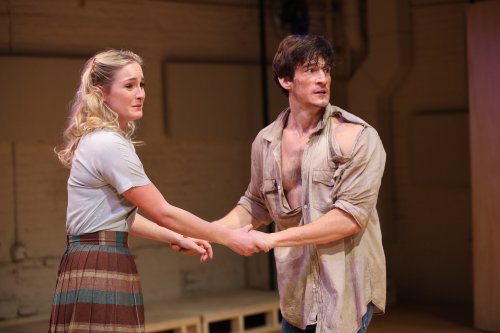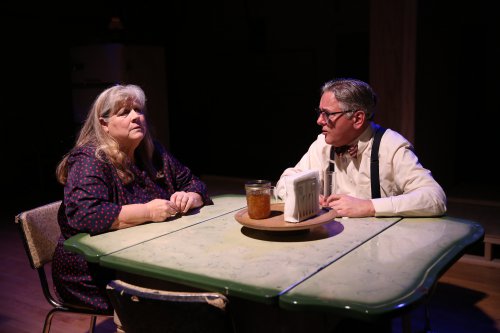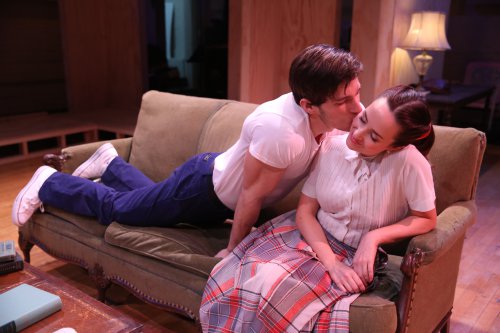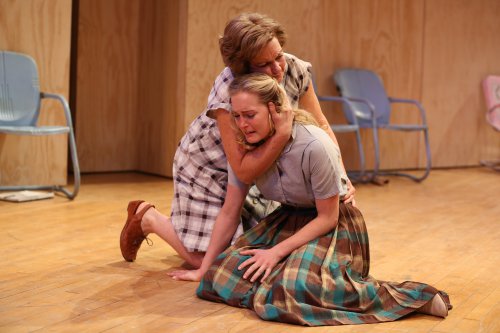William Inge in Rep: Picnic & Come Back, Little Sheba
Heavy-handed direction does not obliterate the power of these two finely acted masterpieces by a relatively neglected playwright ripe for rediscovery.

Ginna Le Vine and David T. Patterson in a scene from William Inge’s “Picnic” (Photo credit: Carol Rosegg)
[avatar user=”Darryl Reilly” size=”96″ align=”left” ] Darryl Reilly, Critic[/avatar]Despite heavy-handed direction, these revivals of two well known, insightful and meticulously written works succeed.
The Off-Broadway, New York City-based Transport Group Theatre Company presents “visually progressive productions of emotionally classic stories that explore the challenges of relationships and identity in modern America.”
Here, with Picnic and Come Back, Little Sheba: William Inge in Repertory, they admirably focus attention on two outstanding plays by this prominent, yet relatively neglected writer.
Unfortunately, but not fatally, Jack Cummings III, the company’s artistic director has erratically staged each of the plays by imposing extraneous directorial devices that sidetrack their effectiveness.
Before he committed suicide by carbon monoxide poisoning in 1973, at the age of 60, William Inge was a leading and award-winning American playwright. His specialty was small town, Middle American angst. He was a contemporary of and was mentored by Tennessee Williams.
Come Back, Little Sheba (1950), Picnic (1953), Bus Stop (1955) and The Dark at the Top of the Stairs (1957) all had successful Broadway runs, and were adapted into noteworthy films. For the 1961, film Splendor in the Grass, he won the Academy Award for his screenplay.
In the 1960’s, his career went into decline with several plays that had brief runs on Broadway. Beset by alcoholism, depression and his life-long torment over his homosexuality, he killed himself.

Heather Mac Rae and Joseph Kolinski in a scene from William Inge’s “Come Back, Little Sheba” (Photo credit: Carol Rosegg)
Come Back, Little Sheba is set in “an old house in one of those semi-respectable neighborhoods in a Midwestern city.” There we meet the middle-aged couple, Doc and Lola Delaney. Passion has long been replaced by affectionate resignation. They creepily call each other “Daddy” and “Baby.”
They were married at the age of 18 after Lola became pregnant. Her father disowned her, but she has contact with her mother. She had a miscarriage and was left unable to have children. Sheba was their dog that they raised from a puppy to old age, and who mysteriously vanished. Doc dropped out of medical school and ekes out a living as a chiropractor. He’s also a recovering alcoholic filled with rage and despair, and has been sober for nearly a year. Lola is equally melancholy, neglecting her physical appearance and the housekeeping.
Their lives of quite desperation are brightened by their boarder Marie. She is a teenage college student who has, “the cheerfulness only youth can feel in the morning.” Though she is to marry the go-getter Bruce, who is in another city, she has been amorously involved with a fellow student, the muscular Turk. Both Doc and Lola get emotionally caught up in Marie’s activities, culminating in a dinner party for the visiting Bruce.
It’s a finely written character study with well-observed dialogue and a plot comprised of the mundaneness of every day life. There is also the theme of the clash of the sourness that can come of age, versus the promise of the young. The play and the actors transcend Mr. Cummings’ intrusive direction.
The pace is slow and serious moments are often undercut by incessant playing for laughs. There’s a lot of Michael John LaChiusa’s anachronistic incidental music, rumbling sound effects, blackouts and dim lighting, and recorded snippets of old-time radio programs are heard throughout.
The excellent actress Heather Mac Rae underplays Lola to the point of catatonia. Still Ms. Mac Rae’s personabilty shines through, and ultimately it’s a moving performance that holds interest. Paddling around in a dingy housedress, the large Mac Rae is visually perfect as the character, as well as conveying her interior sadness.
Wearing suspenders and a boxy suit, the bespectacled, gray-haired and grimly smiling Joseph Kolinski instantly transmits Doc’s hopelessness. Mr. Kolinski gives a knockout performance that skillfully alternates between sunny, sullen and roaring. Kolinski’s drunken outburst is shattering and his subtle but clear facial expressions of lust for Marie are palpable.

David T. Patterson and Hannah Elless in a scene from William Inge’s “Come Back, Little Sheba” (Photo credit: Carol Rosegg)
Hannah Elless is delightfully girlish as Marie. In a white T-shirt and jeans, the highly athletic David T. Patterson’s Turk offers a winning portrait of idealized male youth. Rowan Vickers has a marvelous rat-tat delivery and forceful presence as Bruce.
As Mrs. Coffman the feisty German-born neighbor, Jennifer Piech switches from wonderful comic relief to dramatic effectiveness with great ease. Ms. Coffman makes a vivid impression in this supporting part.
In their brief roles as Doc’s Alcoholics Anonymous sponsors, David Greenspan and Jay Russell are brusquely benevolent. With their sharp features, dark suits and fedoras, they look like Edward Hopper subjects.
Lola’s solitary routines are interrupted by visits from the postman, the milkman and a telegram messenger. All are gratingly played by John Cariani. Mr. Cariani gives three two-dimensional characterizations employing inane vocal and physical mannerisms, in addition to an obviously fake mustache. His performance is another of Cummings’ deleterious flourishes.
Scenic design Dane Laffrey has configured a three-sided, runway playing area sectioned like a railroad flat, with the the kitchen, dining room and living room in a row, all are filled with accurate looking furnishings of the 1940’s. It all vastly complements the actions and is true to the spirit of the play.
Come Back, Little Sheba ran on Broadway for 191 performances. Recreating her Tony Award-winning role of Lola, Shirley Booth won the Academy Award for Best Actress for the 1952 film version. Despite its presentational excesses, this production affirms the play’s power.

John Cariani and Emily Skinner in a scene from William Inge’s “Picnic” (Photo credit: Carol Rosegg)
Picnic was awarded the Pulitzer Prize for Drama in 1953, and ran for 477 performances on Broadway. It takes place on Labor Day in a small Kansas town.
Cummings outdoes himself with the painful opening sequence. The lights come up on Laffrey’s minimal set on an L-shaped playing area. It consists only of modular wooden walls and vintage lawn chairs. For what feels like an eternity, music plays along with the sound of birds chirping. What this signifies only Cummings would know. This barren landscape is certainly symbolic of the characters’ lives but isn’t compelling visually.
Two adjoining houses are represented. One belongs to the magnanimous, middle-aged widow Mrs. Helen Potts who lives with her ailing, unseen mother. The other belongs to the Owens family. They are the widowed Flo, and her two daughters,18-year-old Madge, and 14-year-old Mille. Their schoolteacher boarder is the aging Rosemary Sydney, who yearns to marry her 42-year-old boyfriend, businessman Howard Bevans. Flo urges Madge to cultivate the attentions of her boyfriend, Alan Seymour. He is the scion of a wealthy family and Madge’s marrying him would be advantageous.
He walked through the door, and everything was different.
Hal Carter, a muscular, magnetic young man has recently come to town, and Mrs. Potts has given him odd jobs in return for meals. He was born in Arkansas, survived reform school, and is poor. He and Alan were college roommates and friends. His enticing physical presence and good nature instigates several conflicts amongst the other characters.
There are some bad things about every life.
Inge creates a haunting gallery of individuals struggling with their innermost desires and the class system. The characters are all well delineated, the dialogue is precise, and their clashes convey the pain of the human condition. Inge explores sexuality with great frankness for that time, as well as savaging stifling, middle class morality. There are matter of fact references to smoking marijuana.

With his exceptional physique, great smile and abundant charm, Patterson is perfection as Hal. It is totally clear and believable that his Hal commands universal attention. Whether dancing, recalling his failed Hollywood screen test, sharing his pipe dreams or recounting his hardscrabble life, Mr. Patterson is captivating.
Mrs. Potts’ warm heart and wisdom are beautifully conveyed by Mac Rae. Michele Pawk gingerly captures the maternal harshness and pragmatism of Flo.
As Madge, the radiant Ginna Le Vine masterfully displays a range of emotions as a young girl entering womanhood. Elless’ Millie goes from tomboy to fiery adolescent with delightful force.
Jarringly made up and costumed to resemble Eve Arden in Our Miss Brooks, Emily Skinner as Rosemary is initially chattery but develops her characterization with poignant results. Cariani who was so irritating in Come Back, Little Sheba is terrific here as Howard, the typical, single middle-aged man conflicted about settling down.
Vickers’ sympathetic portrayal of Alan achingly navigates between noblesse oblige and hardheartedness.

Ginna Le Vine and Michele Pawk in a scene from William Inge’s “Picnic” (Photo credit: Carol Rosegg)
Piech and Krystal Rowley as Irma and Christine respectively, make the most of their comic relief roles as fellow, unmarried schoolteacher pals of Rosemary’s. Popping into the action occasionally as a neighborhood boy named Bomber is the animated Stephen Mir, who brings Norman Rockwell-style imagery to the stage while carrying his slingshot.
R. Lee Kennedy’s lighting design is uniformly accomplished, if overused. Sound designer Miles Polaski renders all of the music and sound effects adeptly.
Clothing many characters in two plays is a huge task, and costume designer Asta Bennie Hostetter has assembled an authentic array of garments that illustratively depict the time period and locales.
The musical scores by Michael John LaChiusa are a modern sounding electronic affair with a woman chanting during the one for Picnic. It further reflects Cummings’ auteurist agenda.
Though rather flawed in execution, there is much to enjoy in Picnic & Come Back, Little Sheba: William Inge in Repertory. It is also revelatory in proving William Inge’s high ranking in the annals of dramatic literature.
Picnic & Come Back, Little Sheba: William Inge in Repertory (extended through April 23, 2017)
Transport Group Theatre Company
The Gym at Judson, 243 Thompson Street, in Manhattan
For tickets, call 866-811-4111 or visit http://www.transportgroup.org
Running times:
Come Back, Little Sheba: two hours and ten minutes with one intermission
Picnic: two hours and fifteen minutes with two intermissions






Leave a comment